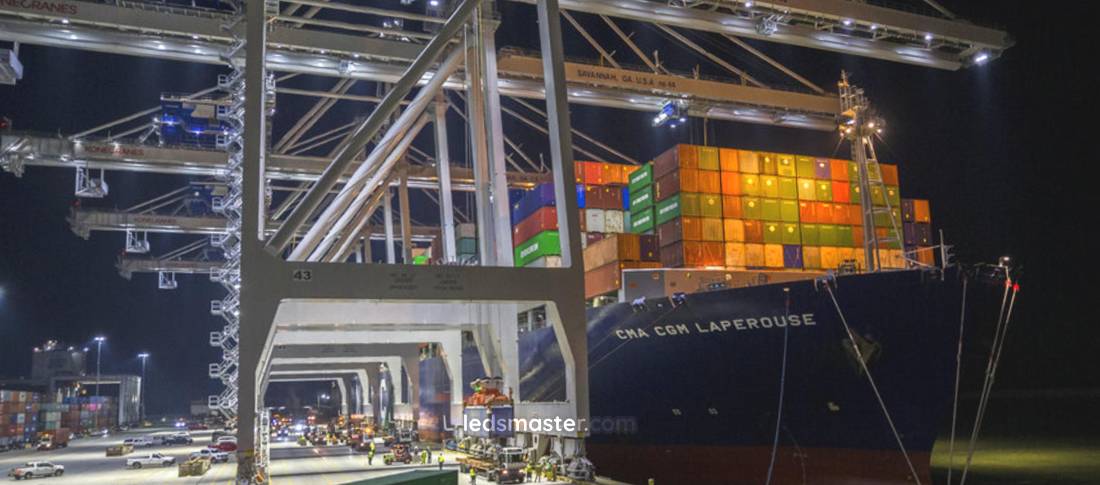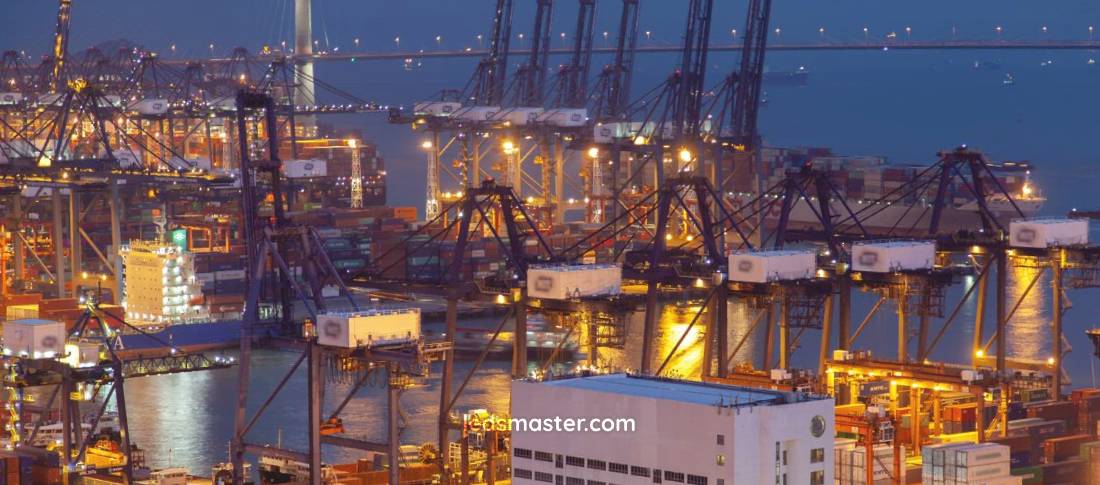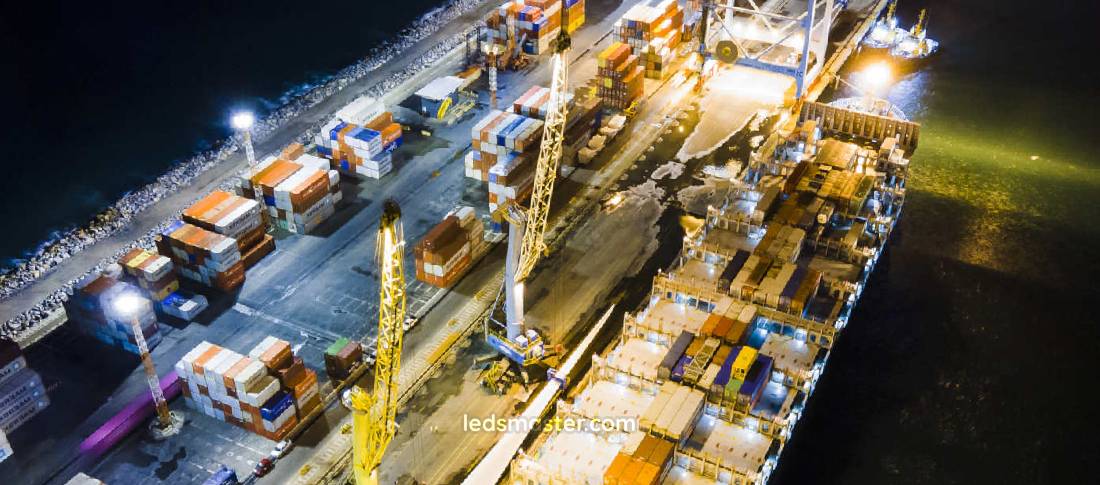Container port lighting is the backbone of 24/7 operations, ensuring the safe and efficient movement of goods across vast areas. In these busy environments, lighting solutions need to withstand harsh coastal conditions, provide optimal visibility for workers, and enhance security.
Get your complimentary lighting design today
Ports operate around the clock, and without proper lighting, the movement of goods can be delayed, safety compromised, and the security of assets at risk. Designing an appropriate lighting system for container ports involves a careful assessment of multiple factors such as layout, environmental conditions, and the specific requirements of different areas within the port. Understanding these factors and employing the right solutions can ensure smooth and productive port activities.
Table of Contents
ToggleContainer ports have a range of areas, from storage yards and loading zones to roadways and docking stations. Each of these areas requires lighting tailored to its function, with considerations for visibility, safety, and operational efficiency. The general lighting levels, measured in lux, differ depending on the area of the port. For instance, the lux levels for open storage yards may range from 20-50 lux, while high-traffic loading areas demand higher illumination levels, around 100 lux or more. Similarly, roadways within the port require enough lighting to facilitate safe navigation of heavy vehicles and machinery.
Different ports must also comply with international standards governing lighting. These standards, set by bodies such as the International Electrotechnical Commission (IEC) or the Illuminating Engineering Society (IES), provide guidelines on lighting intensity, uniformity, and safety. These standards help in designing lighting systems that enhance operational efficiency while maintaining safety for workers and equipment.

Lighting in container ports must meet the varied needs of different zones. Ports typically employ a combination of high-mast lighting, LED floodlights, and specialized lighting for specific areas. Each lighting solution offers unique benefits depending on the intended area of application.
High-mast lighting is frequently used in container ports due to its ability to cover large areas. These tall structures can hold several high-power lamps, which cast wide beams across container yards, loading zones, and other vast spaces. High-mast lighting is ideal for ports where maintaining a broad coverage area without frequent poles is desired. One of the major advantages of high-mast lighting is its ability to reduce the number of lighting poles, which minimizes obstructions within the port’s operational space.
LED floodlights have become a popular choice for container ports due to their energy efficiency and superior brightness. These lights provide focused illumination, making them suitable for areas that require high visibility, such as loading and unloading zones. The use of LEDs offers the additional benefit of low maintenance since they have a long lifespan and are less prone to failure. Their brightness can also be adjusted based on operational needs, ensuring that different areas receive the appropriate lighting without unnecessary energy consumption.
Certain areas of a container port may require specialized lighting due to the presence of hazardous materials or conditions. These zones might involve areas near flammable substances, heavy machinery, or water-sensitive equipment. In such cases, lighting systems are designed with specific protective measures to prevent sparking or contamination. The fixtures in these areas are often explosion-proof and have enhanced durability to withstand potential impact or exposure to harmful substances.
Crane operators and terminal workers need precise lighting to handle the movement of containers. For container cranes, lighting must illuminate both the ground area where containers are loaded and unloaded, as well as the height at which the crane operates. LED fixtures are frequently used in crane lighting due to their precision and ability to produce concentrated light beams. At container yards, which are often filled with rows of containers, lighting should be strategically placed to cover the aisles between containers without creating shadows that could obscure workers’ vision.

Container ports are often located near coastal areas, and lighting systems must be designed with environmental concerns in mind. One of the primary environmental factors is light pollution, which can impact surrounding ecosystems, including marine life. Light pollution occurs when excessive artificial light spills into areas beyond what is necessary, disrupting natural cycles such as the behaviors of nocturnal animals. To mitigate this issue, lighting systems can be designed with features such as shielding and directional control to ensure that light is focused only where it is needed, minimizing light spill.
Using eco-friendly lighting systems can also help reduce environmental impact. Solutions like LED lights, which use less energy, produce less heat, and have a lower environmental footprint, are preferred in container ports. Additionally, dimming controls and motion sensors can be implemented to adjust lighting levels based on operational needs, ensuring that areas of the port are only lit when necessary.
Container ports are exposed to harsh environmental conditions, including saltwater corrosion, strong winds, and UV radiation. Lighting systems must be designed to withstand these challenges without frequent maintenance or failure. One of the key factors in achieving durability is the selection of materials for lighting fixtures.
Being located near the sea, ports are susceptible to saltwater corrosion. The salty environment can accelerate the deterioration of materials, especially metals. Lighting fixtures used in container ports are often made from corrosion-resistant materials such as stainless steel, aluminum, or specially coated metals that can withstand prolonged exposure to saltwater. In addition to the materials used, the fixtures themselves must have protective coatings to prevent rust and corrosion over time.
Strong winds are another challenge for container ports, especially those in coastal regions. High-mast lighting systems and other outdoor fixtures must be designed to withstand high wind speeds. Lighting poles are typically engineered with wind load ratings that can handle extreme weather conditions. Additionally, UV radiation from the sun can cause some materials, especially plastics, to degrade over time. To combat this, UV-resistant materials or coatings are used on lighting fixtures to prolong their lifespan.
The ingress protection (IP) rating of a lighting fixture indicates its ability to withstand dust, water, and other environmental factors. In a port environment, where dust, water splashes, and heavy machinery are common, high IP-rated fixtures are necessary. For example, an IP65 rating means the fixture is completely protected against dust and is resistant to water jets from any direction, making it suitable for outdoor and coastal conditions. Higher IP ratings may be needed for areas prone to heavy water exposure, such as near the shoreline or in areas where cleaning operations are frequent.
Achieving even lighting distribution across the port is critical for smooth operations. Uniform lighting ensures that all areas are sufficiently illuminated, reducing the risk of accidents and enhancing worker visibility. Container ports are often large and open, making it challenging to maintain consistent light levels throughout. However, by carefully positioning lighting fixtures and selecting the right beam angles, uniform lighting can be achieved.
Inadequate lighting uniformity can result in dark spots, which pose safety hazards for workers and create operational inefficiencies. Well-designed lighting systems ensure that each area of the port, from storage yards to roadways, has adequate illumination without creating sharp contrasts between bright and dim zones. Modern LED systems allow for better control of light distribution, ensuring that even the farthest corners of the port are illuminated.
Excessive glare can be disruptive, particularly for workers operating machinery like cranes, trucks, and forklifts. Glare occurs when overly bright light reflects off surfaces, causing discomfort or reducing visibility. In container ports, glare is a concern for both safety and operational efficiency. To reduce glare, lighting systems can incorporate features such as louvers, shields, and anti-glare coatings on fixtures. These features help direct the light downward onto the work areas rather than scattering it in all directions.
For areas where operators are in elevated positions, such as crane cabins, glare from lights below can interfere with visibility. In these cases, low-glare lighting fixtures or lights with diffusers are used to minimize the impact on operators. Additionally, carefully planning the height and angle of lights can prevent direct exposure to workers’ eyes while ensuring the area remains well-lit.
The choice of color temperature and color rendering index (CRI) in container port lighting can significantly affect visibility, safety, and productivity. The color temperature of light refers to the perceived warmth or coolness of the light, measured in Kelvins (K). Cool white light, typically ranging from 4000K to 6000K, is often preferred for container ports because it provides better visibility and contrast, which are critical in outdoor environments and for tasks like handling cargo.

| Area | Color Temperature (Kelvin) | Description |
|---|---|---|
| Main Operational Zones | 5000K – 6000K | Cool white lighting mimics daylight, enhances visibility, reduces eye strain, and improves safety. |
| Administrative Areas | 3000K – 4000K | Warmer light for a comfortable atmosphere in less intensive areas. |
Cool white lighting, around 5000K to 6000K, mimics daylight and enhances visibility in outdoor conditions. This type of lighting is particularly useful for container ports, as it provides workers with a clearer view of their surroundings, reduces eye strain, and improves overall safety during nighttime operations. Additionally, cool white light is better at penetrating fog or mist, which are common in coastal environments, ensuring that operations can continue smoothly in varying weather conditions.
In some areas of the port where less intense lighting is needed, such as administrative or break areas, warmer light, around 3000K to 4000K, may be used to create a more comfortable atmosphere for workers. However, in the main operational zones, cool white lighting remains the most practical choice.
The color rendering index (CRI) measures how accurately a light source reveals the colors of objects compared to natural light. A higher CRI indicates better color accuracy. In container ports, a high CRI is crucial, especially when workers need to read labels, identify cargo, or operate machinery that requires distinguishing between different colors. LED lights generally have a high CRI, often above 80, which is suitable for most port operations.
For areas where precise color recognition is necessary, such as in security checks or when dealing with hazardous materials, lighting with a CRI of 90 or higher may be used. This ensures that colors are represented accurately, reducing the likelihood of errors or misunderstandings.
Lighting plays a central role in ensuring the safety and security of container port operations. Adequate illumination deters unauthorized access, enhances visibility for security personnel, and reduces the risk of accidents. The placement and intensity of lights must be carefully planned to cover key operational areas while also integrating with the port’s overall security systems.
Ports are busy environments, and with the constant movement of goods, machinery, and personnel, security is always a concern. Proper lighting reduces the risk of theft or vandalism by ensuring that all areas are visible to security cameras and personnel. High-mast lights and strategically placed LED floodlights can cover large sections of the port, eliminating dark areas where unauthorized activities could occur.
Lighting also helps security cameras function more effectively. For example, facial recognition and license plate identification systems require adequate lighting to capture clear images. Therefore, ensuring that key access points, roadways, and perimeter areas are well-lit enhances overall security.
Certain areas of a container port, such as entry and exit points, storage yards, and high-value cargo zones, require more focused security lighting. In these areas, lighting systems are often integrated with motion sensors or surveillance cameras. Motion-activated lighting helps conserve energy while providing bright, targeted illumination when movement is detected. This also alerts security personnel to unusual activity and can deter potential intruders.
At entry points, lighting should be positioned to illuminate both vehicles and personnel clearly, aiding in security checks and reducing the chance of unauthorized access. Security lights can also be linked to the port’s alarm system, triggering increased lighting in response to breaches or alarms.
Maintaining a reliable lighting system is crucial for the continuous operation of a container port. The challenging environmental conditions and constant usage of port lighting systems demand regular inspection and upkeep to prevent failures or outages that could disrupt operations or compromise safety.
Regular maintenance ensures that lighting fixtures remain functional and efficient over time. Maintenance teams should frequently inspect lighting systems for signs of wear and tear, corrosion, or malfunction. Saltwater exposure, high winds, and UV radiation can all impact the durability of lighting fixtures, so it is vital to address any issues promptly before they lead to larger problems.
In addition to visual inspections, the electrical components of the lighting system should be tested regularly. Ensuring that wiring, connectors, and switches are functioning properly can prevent sudden outages that could disrupt port operations. Replacing worn or damaged parts as needed can also extend the life of the entire lighting system, reducing the need for costly replacements or repairs.
Routine inspections are an integral part of maintaining an effective lighting system in a container port. Inspections allow for the identification of faulty lights, dimming bulbs, or areas with inadequate illumination. Identifying and addressing these issues early ensures that the lighting system continues to operate smoothly, reducing the risk of accidents or security breaches caused by poor visibility.
Remote monitoring systems are often employed to oversee the performance of the lighting system in real time. These systems alert maintenance teams to any issues, such as power outages or failing bulbs, allowing for quick responses and minimal disruption to port activities. By maintaining a proactive approach to lighting maintenance, ports can ensure their operations remain efficient and safe.
Effective container port lighting is key to maintaining safe, efficient operations in these dynamic environments. By selecting durable, weather-resistant fixtures, ensuring proper light distribution, and integrating security and maintenance protocols, ports can enhance productivity and safety. Thoughtful lighting design not only supports smooth cargo handling but also contributes to a more secure and reliable port infrastructure.